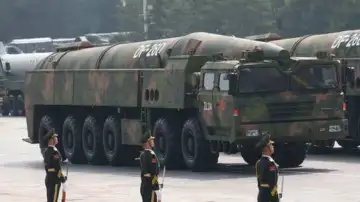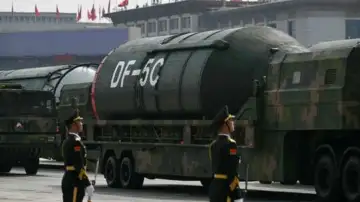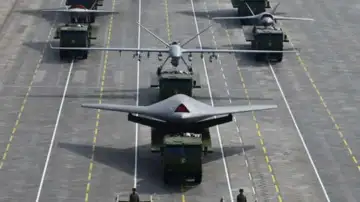As tensions remain volatile in the Indo-Pacific, China’s military modernization has produced an array of advanced weapons systems designed to counter US dominance.
From hypersonic missiles to AI-driven drones, these platforms exploit gaps in American defenses, emphasizing speed, stealth, and precision to deter or defeat US forces in potential conflicts over Taiwan or the South China Sea.
Drawing from recent analyses and China’s September 3, 2025, military parade showcasing new capabilities, this report curates five key Chinese weapons that pose significant challenges to US military power. These selections are based on their technological edge, deployment status, and strategic implications, as highlighted by experts from RAND, BBC, and defense publications.
Dongfeng-26D Intermediate-Range Ballistic Missile (“Guam Killer”)
Among China’s growing arsenal, the Dongfeng-26D (DF-26D) stands out as one of the most potent threats to US power projection in the Pacific. Often referred to as the “Guam Killer,” the missile has a range of 3,000 to 4,000 kilometres, allowing it to strike critical US assets such as Andersen Air Force Base and naval facilities in Guam. Unlike older systems, the DF-26D is both road-mobile and equipped with manoeuvrable reentry vehicles, giving it an ability to evade missile defences while maintaining precision against land and maritime targets, including aircraft carriers.

Operational since 2016, with over 200 launchers estimated to be deployed, the missile has proven its dual role through anti-ship tests in 2024. For Washington, the DF-26D raises questions about the survivability of forward-deployed forces and underlines the vulnerability of fixed bases in the Indo-Pacific.
Dongfeng-5C Intercontinental Ballistic Missile (ICBM)
While the DF-26D challenges US operations in the near seas, the Dongfeng-5C (DF-5C) directly targets the American homeland. An upgraded variant of China’s long-serving ICBM family, the DF-5C has a range of more than 12,000 kilometres and is capable of carrying up to a dozen independently targetable warheads. The missile is housed in hardened silos, enhancing its survivability in a first-strike scenario. Its 2025 parade appearance confirmed its integration into China’s nuclear deterrent, expanding Beijing’s ability to ensure mutual assured destruction.

Analysts point out that the DF-5C, with its MIRV configuration, could overwhelm the limited US Ground-Based Midcourse Defence system. By increasing the scale and sophistication of its nuclear arsenal, China not only strengthens deterrence but also complicates American decision-making in crises such as Taiwan, where escalation ladders are already fraught with risk.
YJ-17 and YJ-19 Hypersonic Anti-Ship Missiles
China’s naval strategy is reinforced by the introduction of the YJ-17 and YJ-19 hypersonic anti-ship missiles, which signal a new era in anti-carrier warfare. The air-launched YJ-17, operational on J-16 fighters, and the sea-launched YJ-19, deployed on advanced Type 055 destroyers, can achieve speeds beyond Mach 5 and strike targets at ranges of up to 1,500 kilometres.
Their flight profiles, combining low-altitude sea-skimming with high-speed terminal manoeuvres, make them exceptionally difficult to track or intercept. For the US Navy, these missiles represent a grave challenge: carrier battle groups, once symbols of unassailable dominance, now face the prospect of being targeted from long distances with minimal warning. Analysts from the BBC warn that such systems could force US carriers to operate well beyond the “second island chain,” limiting their ability to rapidly respond to contingencies around Taiwan or the South China Sea.
Gongji-11 (GJ-11) Stealth Attack Drone
In the skies, China’s Gongji-11 (GJ-11) stealth combat drone adds a cutting-edge dimension to the People’s Liberation Army Air Force’s capabilities. With its sleek flying-wing design, internal weapons bays, and AI-assisted autonomy, the GJ-11 is envisioned as a “loyal wingman” that can accompany advanced fighters like the J-20. Capable of conducting reconnaissance, electronic warfare, and precision strikes, the GJ-11 reduces risks to human pilots while enabling swarm tactics to saturate US air defences.

First tested in 2019, its official debut at the 2025 parade is a strong indication that the system has entered mass production and frontline service. By pairing artificial intelligence with stealth, China is signalling that it intends to compete not just in numbers but in advanced concepts of networked and unmanned warfare, a domain where the US has long held the lead.
LY-1 Directed Energy Weapon (Laser System)
Perhaps the most futuristic of Beijing’s emerging systems is the LY-1 directed energy weapon, which marked its first public debut during the 2025 parade. Mounted on armoured trucks and naval platforms, the LY-1 employs high-energy lasers with an output exceeding 50 kilowatts, effective at ranges of up to 10 kilometres. The system is designed to counter swarms of drones, disable sensors, and blind adversary optics, providing a cost-effective alternative to expensive missile interceptors.
While US forces have experimented with similar concepts, China’s field deployment of such technology demonstrates both ambition and urgency. For the US military, which increasingly relies on unmanned systems for reconnaissance and strike roles, the LY-1 poses a direct operational problem: attrition of drone fleets at negligible cost to the defender.
A Shifting Balance of Power
China’s 2025 arsenal, fueled by a $230 billion defense budget, narrows the US technological gap, per RAND’s scorecard showing “approaching parity” in missiles and air defense. These weapons enable A2/AD, complicating US intervention in Taiwan scenarios and prompting US responses like AUKUS and hypersonic investments. As the US DOD warns, China’s advances could “deny, disrupt, or degrade” US operations, urging alliances and innovation to maintain edge.
